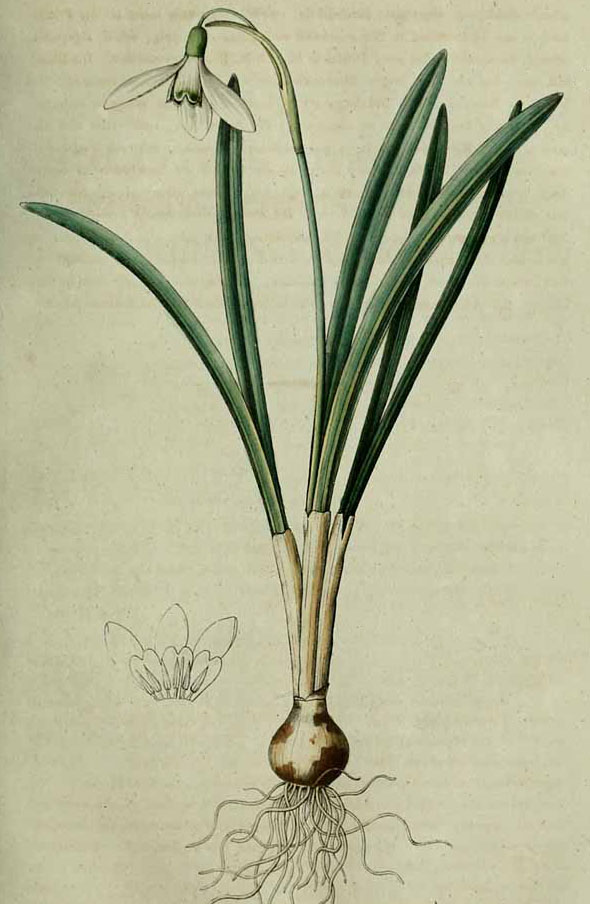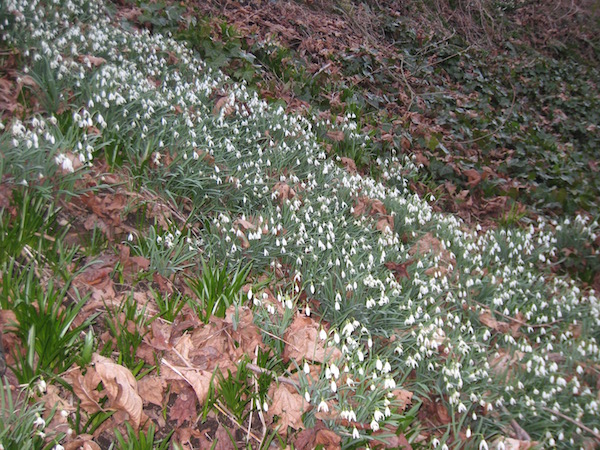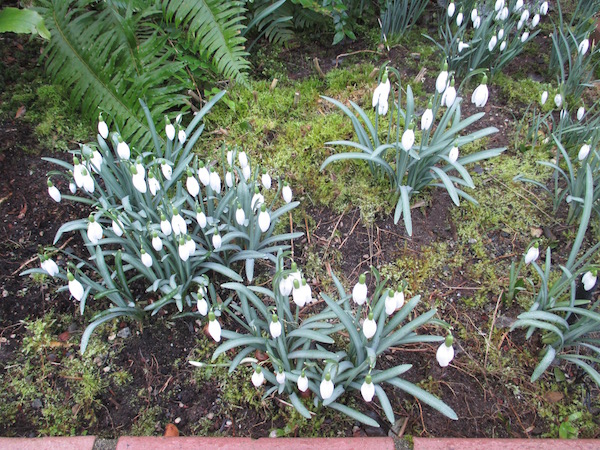| Snowdrop or Milkflower is the English name of a genus of beloved bulbous plants bearing attractive white flowers in earliest spring. They are about the easiest bulbs to grow in gardens. This is a simple introduction to them --entire books exist on these sweet flowers. Read on and learn something new to you. |
| The genus Galanthus was named by Linnaeus in 1753 from the Greek words gala (milk) and anthos (flower); there are about 20 species, virtually all now in cultivation. As a beginner, I struggled to sort Galanthus (Snowdrops) from the related genus Leucojum (Snowflakes). But at least in Seattle, Snowdrops are many times more commonly seen. |
The original, and best known species is Galanthus nivalis. It is native in deciduous woodlands of Europe and the Caucasus. Its pale green leaves and white flowers gleam brightly against wet black soil. John Gerard's Herball of 1597 has this passage describing the Common Snowdrop:
|
"The bulbous Violet riseth out of the ground, with two small leaves flat and crested, of an overworne greene colour, between which riseth up a small and tender stake of two hands high; at the top whereof commeth forth of a skinny hood a small white floure of the bignesse of a Violet, compact of six leaves, tipped at the points with a light greene; the smaller are fashioned into the vulgar forme of a heart, and prettily edged about with green; the other three leaves are longer, and sharp pointed. The whole floure hangeth downe his head, by reason of the weak foot-stalke whereon it groweth. The root is small, white, and bulbous. Some call them also Snow drops. They are maintained and cherished in gardens for the beautie and rareness of the floures, and sweetnesse of their smell."
|
| To grow Galanthus outdoors in a temperate climate, plant the bulbs a few inches deep, in sun or shade. If in congenial soil, the population will increase by both bulb offsets and seeding. No need to divide, deadhead, stake, or water. Not prone to disease or bugs. Easy as it gets. In Seattle, they bloom mainly in February or early March. |
| To force bulbs indoors, Rob Proctor's book The Indoor Potted Bulb states: "All forms of snowdrops grow easily in pots with little coaxing, but they should be planted touching each other --bulb to bulb-- or the show will be scant." |
| Many cultivars of Galanthus nivalis exist. This species also has plentiful folklore, and poetical references. In the British Isles it has been thought unlucky to cut blooming snowdrop flowers to bring into a house. Other names are Flower of Hope, and Fair Maid of February. In the Language of Flowers, Snowdrops signify variously hope; consolation; friendship in adversity; refinement. |
| Historically, Galanthus nivalis has been used a bit in herbal medicine. More recently, it has been used to treat glaucoma and Alzheimer's disease; and its mannose-binding lectins have been used to treat AIDS, and used in GMO tinkering. There are some toxic isoquinoline phenanthridine alkaloids in the plant, too. Ingestion can cause nausea, vomiting, diarrhea and dizziness. |
| Other than Galanthus nivalis, the two species most grown for ornament are G. Elwesii (Giant Snowdrop) and G. plicatus. Garden and wild hybrids do exist. |
As is very often the case, few people are aware that some Galanthus are eaten by humans. G. angustifolius bulbs are eaten in Kabardino-Balkaria. (Dikorastushchie rastenija v tradicionnoj pishche Kabardincev [Wild Plants --the traditional foods of Kabardians] by Safarbi Hasanbievich Shkhagapsoiev et al. 2003). From the CITES Bulbs website I quote:
|
"Galanthus angustifolius is probably the least well known of all snowdrop species. It was described by J.I. Koss in 1951, from the Russian Republic of Karbardino-Balcaria, in the northern Caucasus. The name angustifolius means "narrow-leaved" in Latin, a very appropriate name for a species with leaves just 2 - 5 mm wide. Galanthus angustifolius is an extremely rare plant in European gardens."
|
| And Galanthus flowers and bulbs of uncited species are eaten as snacks in the north Caucasus. (The Social Context of Wild Leafy Vegetables Uses in Shiri, Daghestan by Iwona Kaliszewska & Iwona Kolodziejska-Degórska in Journal of Ethnobiology and Ethnomedicine 11:63 2015) |
| I do not know if the above-mentioned north Caucasian Galanthus consumed are toxin-free unlike the familiar Galanthus nivalis, or whether they are rendered safe by cooking. Maybe someone who can read Russian can learn more about the matter. |
| As for the common Snowdrop Galanthus nivalis, Francois Couplan's book Le Régal Vegetal says (translated from French): "Flowers used in England to prepare a fermented beverage with water, rice, sugar, raisins and yeast --Snowdrop Wine." |
The expert drawing below is by A.G. Dietrich, from Flora Regni Borussici (1832 - 1833).
Back |

Galanthus nivalis drawing
|

Galanthus nivalis; Common Snowdrops naturalized in Seattle; photo by ALJ
|

Galanthus nivalis; Common Snowdrops in a garden; photo by ALJ
|

